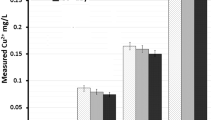Abstract
Studies were performed to evaluate the toxic effects of ammonium sulphate and urea (chemical fertilizers currently applied in ricelands of Cameroon) against eggs, juveniles, and adults of two species of freshwater snails (Helisoma trivolvis andBiomphalaria havanensis). Results obtained from ammonium sulphate tests indicated 24-h LC50 values of 558 mg/L and 669 mg/L for eggs; 393 mg/L and 526 mg/L for juveniles, and 701 mg/L and 657 mg/L for adults ofH. trivolvis andB. havanensis, respectively. Similar analysis with urea revealed LC50 values of 14,241 mg/L and 13,532 mg/L for eggs; 18,255 mg/L and 24,504 mg/L for juveniles and 30,060 mg/L and 26,024 mg/L for adults ofH. trivolvis andB. havanensis, respectively.
Following 48 h exposure, the concentrations of ammonium sulphate killing 100% of snails were 1,250 mg/L and 1,000 mg/L for the adults ofH. trivolvis and ofB. havanensis, respectively. Those of urea were computed to be 25,000 mg/L forH. trivolvis and 35,000 mg/L forB. havanensis. In rice culture in Cameroon, these fertilizers are applied at doses of 100 kg/ha (ammonium sulphate) and of 150 kg/ha (urea); hence, the above found concentrations lethal to snails appeared to be 10 to 13 times (ammonium sulphate) and to be 165 to 235 times (urea) higher assuming an average water depth of 10 cm in these ricefields. Therefore, the use of ammonium sulphate and urea as chemical fertilizers in ricelands of the Republic of Cameroon might adversely affect the survival of freshwater snails only in the case of spills or of stressful environmental conditions. Under normal laboratory conditions, both chemicals show a low molluscicidal activity with urea being about 25 to 35 times less potent than ammonium sulphate.
Similar content being viewed by others
References
Hamdy EI, Ahmed THE, Amin FMA, El-Matarawy OM, ElRahimy HM (1984) Laboratory studies on the ovicidal and larvicidal effects of some artificial fertilizers. J Egypt Soc Parasitai 14(1):131–136
Hopf HS, Muller LR (1962) Laboratory breeding and testing ofAustralorbis glabratus for molluscicide screening. Bull Wld Hlth Org 27:783–789
Perret P, Egger M, Degremont AA (1972) Essai de lutte antimollusque par augmentation de la biomasse planctonique et traitement molluscicide: Association Urea-N-Tritylorpholine. Acta Tropica 29(2):175–181
Ritchie LS, Frick LP, Berrois-Duran LA, Fox I (1963) Molluscicidal qualities of sodium pentachlorophenate (NaPCP) revealed by 6-hour and 24-hour exposures against representative stages and sizes ofAustralorbis glabratus. Bull Wld Hlth Org 29:421–427
Author information
Authors and Affiliations
Rights and permissions
About this article
Cite this article
Tchounwou, P.B., Englande, A.J. & Malek, E.A. Toxicity evaluation of ammonium sulphate and urea to three developmental stages of freshwater snails. Arch. Environ. Contam. Toxicol. 21, 359–364 (1991). https://doi.org/10.1007/BF01060356
Received:
Revised:
Issue Date:
DOI: https://doi.org/10.1007/BF01060356




